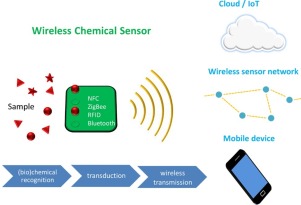Sensors and Actuators B: Chemical ( IF 8.4 ) Pub Date : 2018-03-17 , DOI: 10.1016/j.snb.2018.03.074 Petar Kassal , Matthew D. Steinberg , Ivana Murković Steinberg

|
Parallel advances in chemical sensing and wireless communication technologies have sparked the development of wireless chemical sensors (WCSs). These hybrid devices enable wireless determination, collection and distribution of (bio)chemical analytical information in a way that is significantly impacting the Sensor Internet of Things with applications in healthcare, defence, sport, the environment, and agriculture. Challenges and examples for each of the major chemical sensor and major radio technologies related to different application areas are reviewed, including the latest trends emerging from wearable sensors. The review focuses on radio-based WCSs, and finds that ubiquitous wireless technologies such as Bluetooth, ZigBee, radio-frequency identification (RFID) and near-field communication (NFC) are helping make analytical (bio)chemical sensing appropriate and realistic for mass market adoption, in particular for two major classes of chemical sensor – electrochemical and optical. The review provides an in-depth analysis of academic WCS research publications over the ten year period 2007–2017.
中文翻译:

无线化学传感器和生物传感器:综述
化学传感和无线通信技术的并行发展推动了无线化学传感器(WCS)的发展。这些混合设备以对医疗,国防,体育,环境和农业中的应用产生重大影响的传感器物联网的方式,能够无线确定,收集和分发(生物)化学分析信息。回顾了与不同应用领域相关的每种主要化学传感器和主要无线电技术的挑战和示例,包括可穿戴设备出现的最新趋势传感器。这篇评论集中在基于无线电的WCS上,发现诸如蓝牙,ZigBee,射频识别(RFID)和近场通信(NFC)之类的无处不在的无线技术正在帮助使分析(生物)化学传感适合大众化市场采用率,特别是针对化学传感器的两大类-电化学传感器和光学传感器。该评论对2007-2017十年期间的WCS学术研究出版物进行了深入分析。


























 京公网安备 11010802027423号
京公网安备 11010802027423号